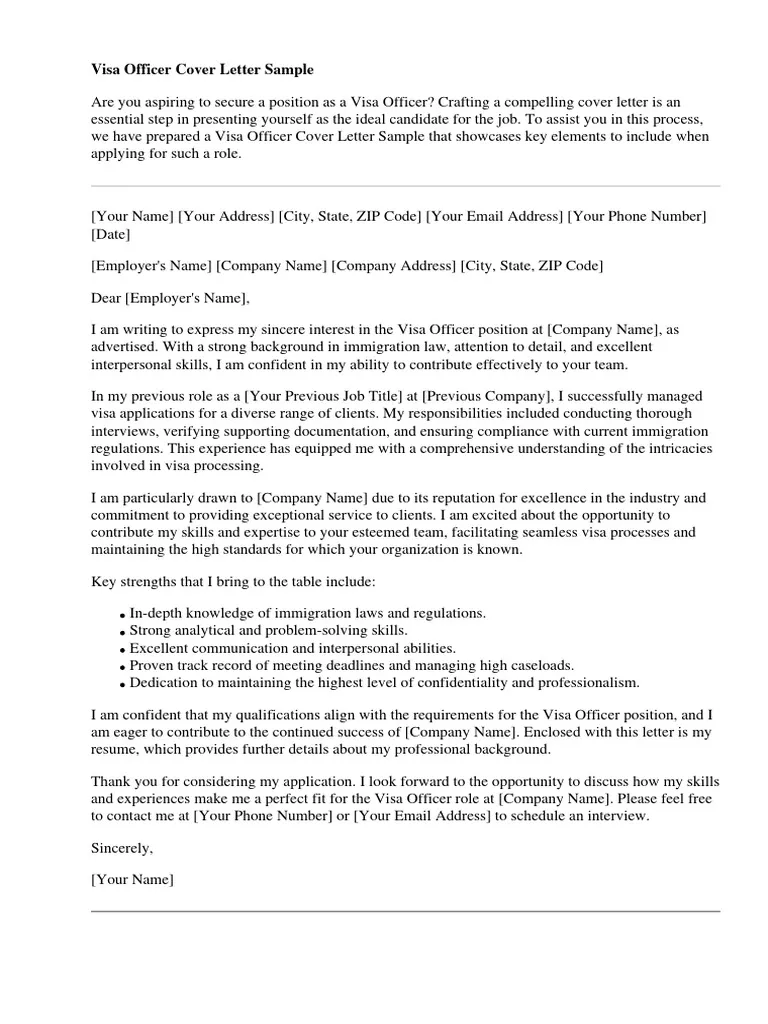Understanding the Importance of a Visa Cover Letter
A well-crafted visa cover letter is a critical component of your visa application, often playing a significant role in the decision-making process of visa officers. This letter serves as your personal introduction and explanation for your travel, providing context to your application and offering additional information that may not be readily apparent in your other supporting documents. It’s your opportunity to present your case persuasively, demonstrating your intentions, and assuring the consulate of your eligibility to enter their country. A strong cover letter can clarify ambiguities, address potential concerns, and increase your chances of visa approval. Failing to submit a comprehensive and convincing cover letter can lead to delays or even rejection, making it essential to dedicate sufficient time and effort to its creation. The key is to be clear, concise, and honest throughout the process.
Why a Cover Letter is Crucial
The significance of a cover letter extends beyond simply stating your purpose of travel. It’s an opportunity to showcase your genuine intentions, build trust, and provide assurance to the visa officer. The letter lets you explain the reasons behind your trip in detail, providing context and addressing any potential concerns the visa officer may have based on your application. Furthermore, it’s where you highlight your ties to your home country, which reduces the risk of overstaying the visa. This demonstrates that you have strong incentives to return and are not a flight risk. In essence, the cover letter allows you to proactively manage perceptions and provide a more complete picture of your circumstances, increasing the likelihood of a favorable decision on your visa application. Remember, a well-written letter is a direct communication channel to the visa officer.
Key Elements of a Compelling Cover Letter
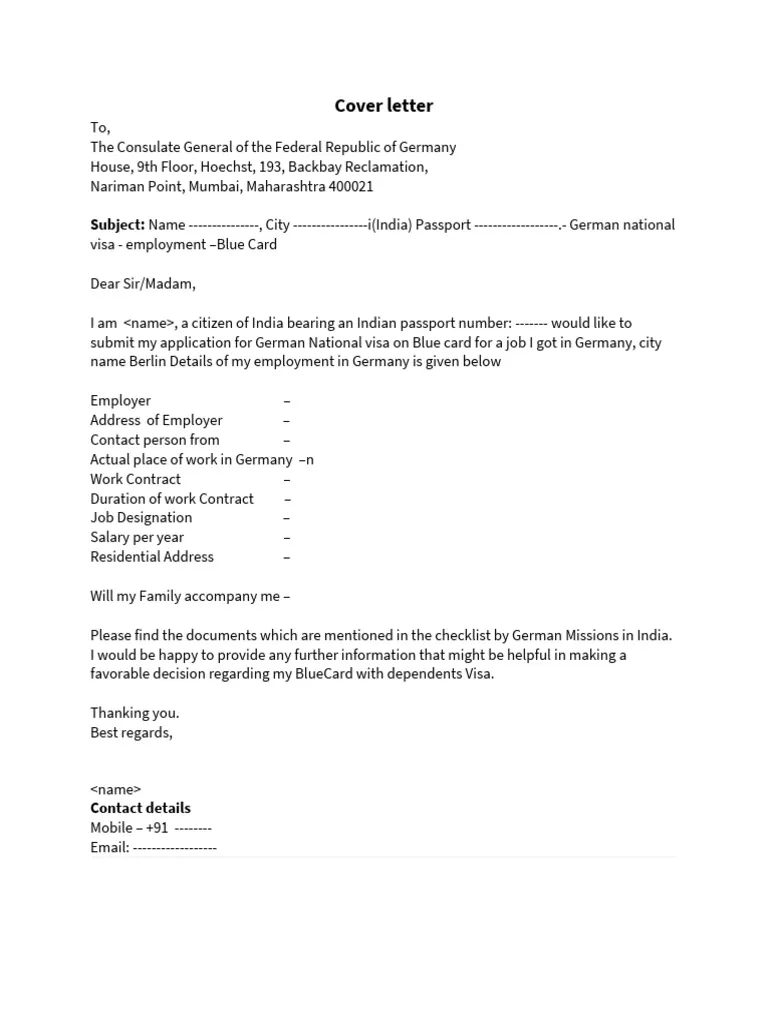
A compelling cover letter should be clear, concise, and comprehensive, covering all necessary aspects of your travel plans. Start by clearly stating your purpose of visit, be it tourism, business, education, or other, and the duration of your stay. Provide detailed information about your travel itinerary, including dates, cities, and planned activities. Include information about your financial stability, demonstrating that you have sufficient funds to support your trip. Emphasize your ties to your home country, such as family, employment, or property, which indicate your intention to return. Ensure the letter is personalized, reflecting your unique circumstances, and address any potential concerns a visa officer may have. Always maintain a professional tone, use clear language, and double-check for any grammatical errors or typos. Remember to sign the letter and include your contact information.
Personal Information and Purpose of Visit
The initial section of your cover letter should introduce yourself and clearly state the purpose of your visit. Begin with your full name, date of birth, and address, mirroring the details in your passport. State the type of visa you are applying for and the reason for your travel. Whether it’s for tourism, business, study, or a family visit, provide a brief overview of your intentions. Be explicit and straightforward; this sets the foundation for your entire application. Explain the main goal of your trip in the first paragraph, so the visa officer immediately understands why you are applying. This early clarification is essential for setting the correct tone and establishing your credibility right from the start.
Applicant’s Full Name and Contact Details
Begin your cover letter by providing your full legal name as it appears on your passport, your current address, phone number, and email address. This information ensures the visa officer can quickly and easily identify your application and contact you if necessary. Make sure all the details are accurate and up-to-date. Including this information at the beginning of the letter helps the visa officer quickly confirm your identity and facilitates efficient communication. Accuracy in personal details is very crucial for a smooth application process. Always verify your contact information to prevent any delays or misunderstandings during the visa application review.
Purpose of Travel and Duration of Stay
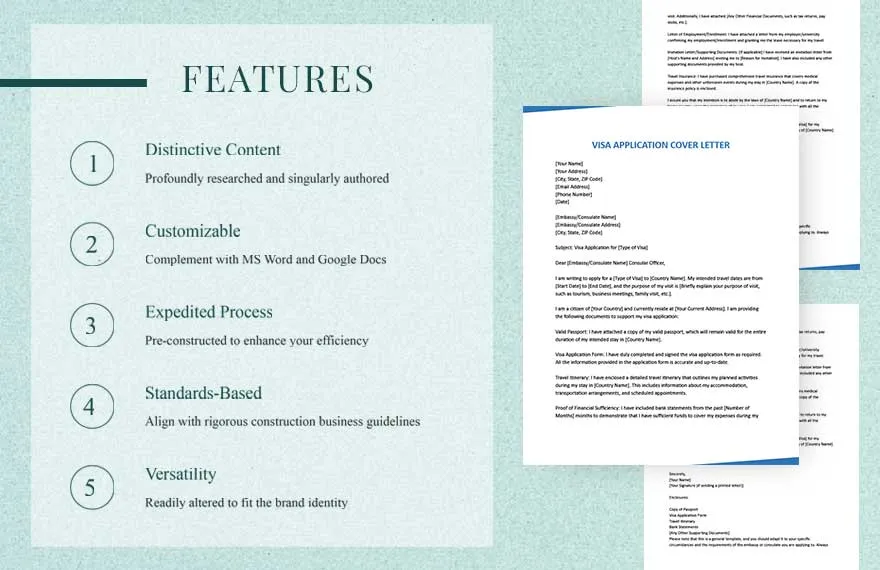
Clearly state the purpose of your travel and the intended duration of your stay. Be specific, whether your visit is for tourism, attending a conference, or any other reason. Mention the specific dates of your trip – start and end dates – and the total number of days you plan to stay. If your purpose is tourism, include the places you intend to visit. If it’s for business, give the name of the company you’re visiting or the event you are attending. Providing a clear, concise, and verifiable purpose of visit ensures the visa officer understands the objective of your trip, reducing the chances of confusion and potential rejection. Align the stated duration with the supporting documents you provide, such as flight bookings and hotel reservations.
Detailed Itinerary and Supporting Documents
A well-defined itinerary provides the visa officer with a clear understanding of your planned activities during your visit. Include specific details about your travel route, accommodations, and activities. Attach copies of all supporting documents, such as flight bookings, hotel reservations, and any other relevant materials that substantiate your plans. This not only strengthens your case but also reassures the visa officer of your genuine travel intentions. By presenting a detailed and organized itinerary, you demonstrate that you have planned your trip carefully and are well-prepared for your journey. Always keep the information consistent across all your documents, including your application form.
Travel Itinerary Details
Include a detailed day-by-day or activity-by-activity breakdown of your planned activities. Mention the cities and places you intend to visit, along with the planned dates for each location. If you are traveling for tourism, specify which attractions you plan to see. If you are attending a conference or event, include the event name, location, and dates. If you are traveling with a group, mention the names and relationships of your travel companions. Providing a clear itinerary helps the visa officer understand your travel intentions and assess the likelihood of your compliance with visa terms. Use a clear and organized format to present your travel plans, making it easy for the visa officer to follow.
Supporting Documents Required
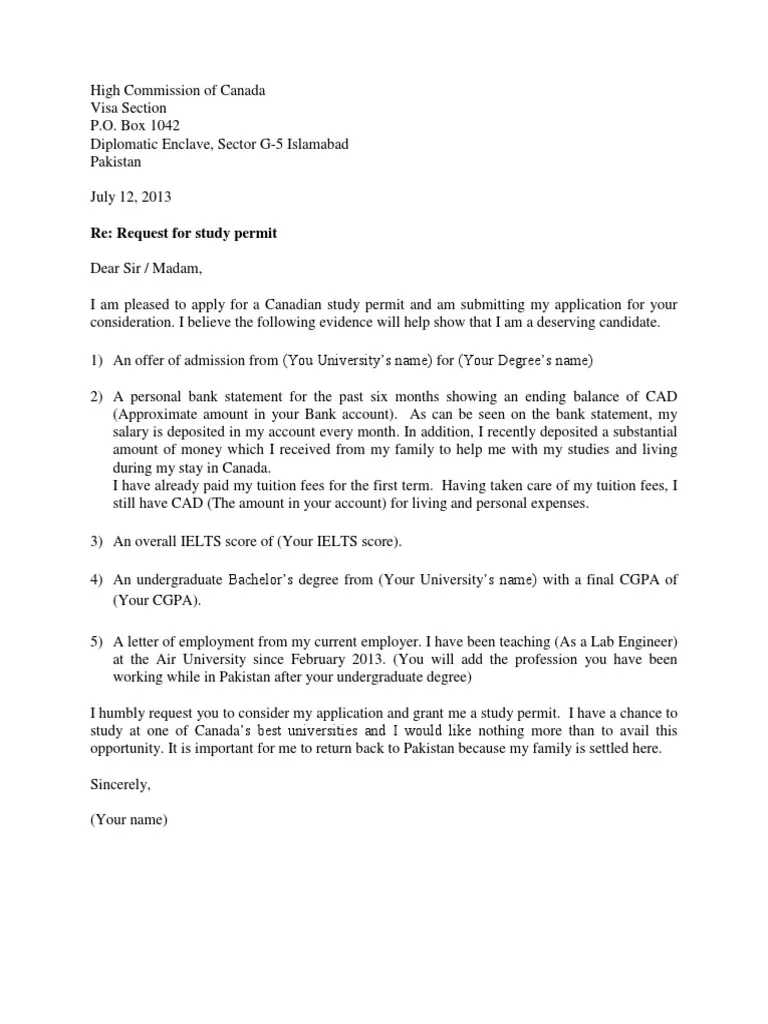
Accompany your cover letter with all necessary supporting documents to validate your application. Include a copy of your passport, visa application form, flight bookings, hotel reservations, and any invitations (if applicable). If you are traveling for business, attach a letter from your employer. If you are sponsored, provide a sponsorship letter, bank statements, and proof of funds. Ensure that all documents are clear, well-organized, and accurately reflect the information provided in your cover letter. Submitting all required documents makes the visa officer’s job easier and increases the chances of a successful application.
Financial Stability and Proof of Funds
Demonstrating your financial stability is an essential aspect of your visa application. Visa officers need assurance that you can support yourself financially during your visit and that you do not intend to work illegally. This section should provide clear evidence of your financial resources. Present bank statements, proof of employment, and any other financial documents that support your ability to cover your travel expenses. The proof of funds requirements vary by country, so verify the specific requirements for your destination. By providing concrete proof of your financial stability, you reassure the visa officer that you are capable of funding your trip and are less likely to become a burden on the host country.
Demonstrating Financial Resources
Clearly state how you will finance your trip, including the sources of your funds. If you are using your own savings, provide recent bank statements. If you are being sponsored, include a sponsorship letter from the sponsor, along with their bank statements and proof of relationship. If you are employed, attach a letter from your employer verifying your salary and employment status. Be transparent and provide accurate information about your financial resources. It is very important to align all the financial details provided in your cover letter with supporting documents. Always provide documentation to support any claims regarding your finances.
Bank Statements and Other Financial Documents

Include copies of your recent bank statements, showing sufficient funds to cover your travel expenses, including accommodation, travel, and daily living costs. Ensure the bank statements cover the required period and reflect a clear picture of your financial activities. If you have other assets, such as property or investments, you can also include copies of relevant documents to provide additional proof of your financial stability. Showing a steady source of income and sufficient funds in your bank account is a clear indicator of your ability to finance your trip. Keep your bank statements organized and highlight any significant deposits or transactions. Always ensure that the dates on the statements match the period of your intended stay.
Family Ties and Ties to Home Country
Demonstrating strong ties to your home country significantly reduces the risk of overstaying your visa. Visa officers want to be assured that you will return to your home country after your visit. In your cover letter, provide detailed information about your family, property, employment, and other commitments that tie you to your home country. This reinforces your intention to return and is a crucial factor in visa approval. Always be honest and include accurate information about your situation; the more compelling your ties, the better your chances of visa approval. This assures the visa officer of your intentions to abide by the terms of your visa.
Family Information
Provide details about your family members residing in your home country. This includes their names, relationships to you, and their contact information. If you have a spouse, children, or parents who depend on you, mention this. This information reinforces the likelihood that you will return to your home country. If any family members will be traveling with you, specify their details as well. Providing information about family ties demonstrates your commitment to your home country and increases the likelihood of visa approval. Ensure that the information you provide is consistent with the information in your application form and other supporting documents.
Reasons for Returning Home
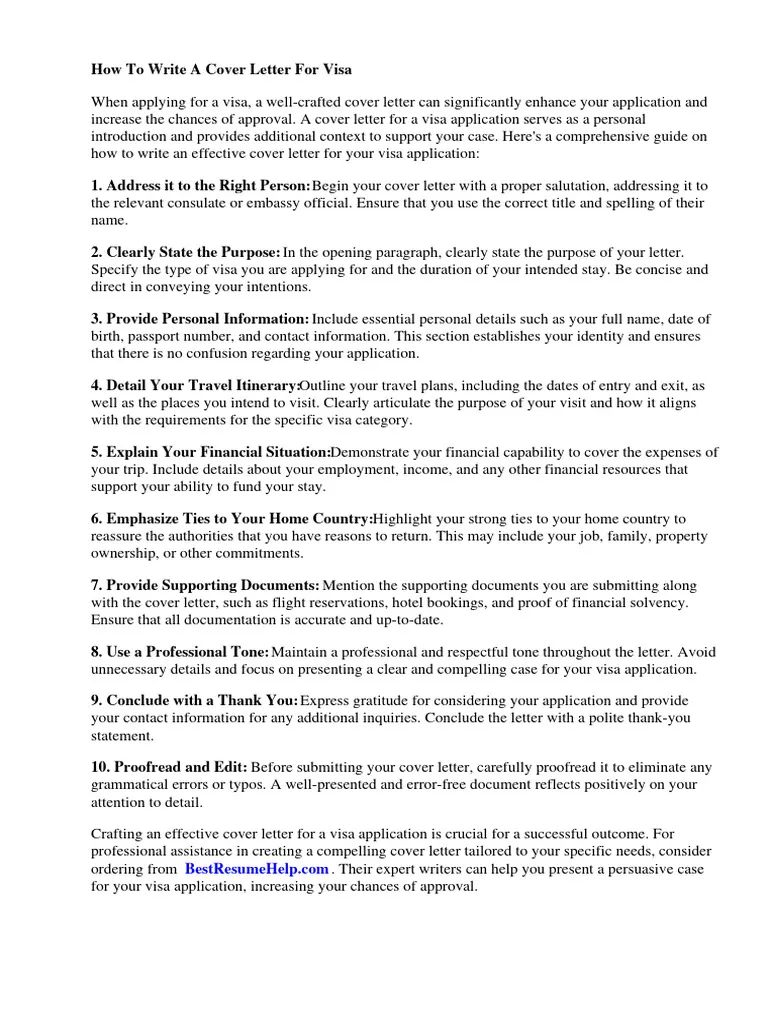
Clearly articulate your reasons for returning to your home country after your visit. This can include your job, business, family responsibilities, property ownership, or any other compelling reasons. If you have a job, provide a letter from your employer confirming your employment and stating that your position will be held for you. If you own property, you can provide copies of property deeds or other relevant documents. The more solid and convincing your reasons for returning, the more confident the visa officer will be in your intentions. Clearly stating your ties will ease concerns about the possibility of you overstaying your visa.
Closing and Signature
The closing of your cover letter should be polite and professional. Thank the visa officer for their time and consideration. Reiterate your commitment to abiding by the visa rules and regulations. Include your contact information, such as your phone number and email address, in case the visa officer needs to reach you. Sign your name at the end of the letter. A well-crafted closing reinforces your sincerity and commitment, while the signature confirms the authenticity of your application. Make sure your closing is formal and expresses your respect for the process.
Polite Closing and Contact Information
In your closing paragraph, express your gratitude for the visa officer’s time and consideration of your application. Reiterate your commitment to adhering to the terms of your visa. Include your full name, phone number, and email address so the visa officer can easily contact you if they have any questions. Make sure your contact information is accurate and up-to-date. A professional and courteous closing reflects your respect for the visa application process and increases the positive impression you make on the visa officer. Always ensure your closing is formal and professional.
Sign Off

Conclude your cover letter by signing your name. This signifies that you have read the information and confirm its accuracy. If you are submitting a digital application, you may be asked to provide an electronic signature. If submitting a physical copy, sign your name in blue or black ink above your typed name. The signature authenticates the letter and confirms that the information provided is correct. Always sign the letter with the same name as in your passport and application. The signature confirms the authenticity of your claims and is an essential part of the application process.
